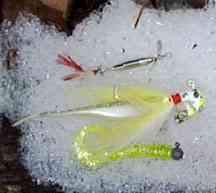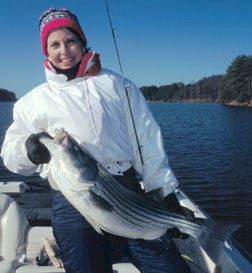Winter Madness for Stripers
Winter Madness for Stripers
By Bill Vanderford
While peering into my binoculars through the eerie mist that always rises from the water on a cold, winter morning, I picked up a flash of water that caught some of the dawn’s first rays of light near the mouth of one of Lake Lanier’s major creeks. I knew in an instant that those distinct splashes were caused by a marauding school of stripers that were in hot pursuit of shad trying desperately to escape. More than twenty years of seeing this frantic action during the colder months from December through April immediately started my blood boiling and my adrenaline pumping.
I jumped down into the driver’s seat of the boat, fired up the big Evinrude Ficht and aimed the boat at the feeding fish. Even before the boat came to a complete stop, both of my clients and myself had already cast bucktail jigs into the foaming water, and within seconds, we were all stumbling around the boat with rods bent almost to the breaking point. As usual, none of the big linesided fish headed in the same direction, so we were passing rods under other rods and running constantly from one end of the big Triton bass boat to the other.
 Unlike largemouth and spotted bass, which are really members of the sunfish family, striped bass and white bass are the only true bass found in Lake Lanier. The striped bass is an eating machine that can convert useless shad into highly desirable gamefish pounds.
Unlike largemouth and spotted bass, which are really members of the sunfish family, striped bass and white bass are the only true bass found in Lake Lanier. The striped bass is an eating machine that can convert useless shad into highly desirable gamefish pounds.
In Lake Lanier, stripers seem to grow even faster than at other lakes. Great water quality and a tremendous baitfish supply are responsible. Plenty of tiny threadfin and gizzard shad, plus an ample supply of recently introduced blueback herring contribute to the above average growth of Lanier's stripers. In addition to the speedy growth rate, striped bass exhibit a fighting strength and stamina which far exceeds that of black bass. Their only negative quality is the lack of aerial acrobatics when hooked, although stripers often leave the water when attacking a surface plug.
Though stripers and black bass sometimes compete for the same baitfish, adult stripers tend to feed in areas of the lake not heavily inhabited by the black bass. Therefore, no evidence has been shown that the stripers have hurt black bass populations at Lake Lanier.
 Lanier's stocking program for striped bass was started in 1973 with 60,000 fingerling stripers, followed in 1975 with an additional 40,000, and again in 1977 with another 40,000. The program was discontinued at the end of 1977 until a study could be done as to the compatibility of the striper and trout populations. It was found that they could both live in harmony, and the stocking program was resumed in 1982. 118,000 fingerling stripers were stocked that year, and plans were made to continue stocking at a rate of one per acre per year, or approximately 40,000 fingerling stripers annually. That rate, however, was changed to 10 per acre, per year, or nearly 400,000, after the trout program was halted in 1987. This increased stocking has allowed Lake Lanier to compete with Santee-Cooper and the T.V.A. lakes in total numbers of trophy striped bass.
Lanier's stocking program for striped bass was started in 1973 with 60,000 fingerling stripers, followed in 1975 with an additional 40,000, and again in 1977 with another 40,000. The program was discontinued at the end of 1977 until a study could be done as to the compatibility of the striper and trout populations. It was found that they could both live in harmony, and the stocking program was resumed in 1982. 118,000 fingerling stripers were stocked that year, and plans were made to continue stocking at a rate of one per acre per year, or approximately 40,000 fingerling stripers annually. That rate, however, was changed to 10 per acre, per year, or nearly 400,000, after the trout program was halted in 1987. This increased stocking has allowed Lake Lanier to compete with Santee-Cooper and the T.V.A. lakes in total numbers of trophy striped bass.
When fishing for stripers, one must remember that a thirty pound striper only has a mouth the size of a five or six pound largemouth bass. Therefore, the really big baits and heavy tackle are not always needed. One can easily catch these huge stripers using 8 to 10 pound line on a spinning reel with a medium-heavy graphite worm rod. Also, the lighter gear and smaller opening of the striper's mouth allows one's bait size to be reduced. Many of the strikes that are often missed with larger lures are easy to hook with the smaller ones.
Probably the most popular and productive method for locating stripers during the winter and spring at Lake Lanier is to follow the birds. Over the past ten years, we have experienced an annual "coming of the birds". This migration generally begins when the water becomes very cold in late December, and the combination of mostly seagulls and loons remains until the water warms considerably in late April.
Since the reason for the birds being here is to feast on the millions of shad that become weak and slow from the cold water, they act like pointers to a quail hunter. An angler can easily spot the hundreds of white seagulls circling frantically and diving into the water to capture the fleeing shad.
The reason so many shad are close to the surface, however, is the big schools of striped bass. They often start feeding on the shad in deeper water, but the shad usually end up being herded to the surface where their luck usually runs out. These big schools of trapped shad become the main course meal for the stripers and loons from below and the seagulls from above.
The great part of this wild feeding frenzy for anglers is that, because of the seagulls, this action can be seen from a great distance across the lake. Therefore, all fishermen have to do is ride and look to locate schools of stripers.
Since the fish and birds are usually preoccupied with their eating, it is often easy to get within casting distance before spooking them. The actual catching then is fairly simple.
Though topwater lures will work and are fun to use, we have found that jigs of different types are more productive. My favorites include the 1/2 ounce Blakemore RoadRunner with bucktail hair, a 1/8 ounce leadhead jig dressed with a 3-inch, chartreuse Ranger curlytailed grub, or my 1/4 ounce Swirleybird Spinner.
Just cast any of these lures into the churning water among the feeding birds and fish. Always let the lure fall a little before reeling it slowly and steadily back or working it in a stop-and-jerk fashion. Often a striper will inhale one of these offerings immediately, but it’s possible to make a hundred casts into these feeding fish and not get a hit. One must always keep in mind that as many as a million real, live shad can be in the middle of one of these feeding sprees. Therefore, persistence is the key, and remember that the only advantage we have is that if we move the lure slower than the real shad move, our offering is easier for the stripers to find.
Unlike black bass, stripers are normally not structure oriented. They are an open water eating machine and always go where the most food is found.
Even with that knowledge, one must often make thousands of casts to be successful in Lake Lanier. However, the catch of a lifetime may be only one cast away. I have hooked as many as thirty stripers over twenty pounds on a single outing, and it only takes one to make a trip worthwhile.
Few fishing experiences can match the total chaos of casting into a school of huge stripers wildly chasing millions of frantically fleeing shad. Muscles will strain and hearts will pound, but one will not soon forget the exciting adventure of Winter Madness For Lanier Stripers!
Find out more about Bill Vanderford on his website http://www.fishinglanier.com, or drop him an email at [email protected]
|
